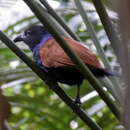Biology
provided by Arkive
Little is currently know about the biology of the short-toed coucal. It is believed to be solitary and to reside in the same location throughout the year. It forages on the ground, feeding upon insects as well as larger animals (3). In a display of opportunistic predation, this species was once observed preying on birds trapped in a mistnet, killing as many as it could reach by biting at their heads (4).
The short-toed coucal builds an untidy nest consisting of leaves lined with palm-frond pith. Nestlings have been recorded in March and fledglings in May, and both parent birds are believed to attend to the chicks (3).
Conservation
provided by Arkive
Protection for the short-toed coucal exists in the Malaysian state of Sabah in Borneo, and for those populations found in a few protected areas throughout the rest of its range. Increased enforcement of protected areas and a reduction in logging activity are vital if the lowland forest that supports the short-toed coucal and many other species is to be preserved (2). In addition, more information is required about the short-toed coucal's population, distribution and ecology, so that specific conservation strategies can be developed (4).
A recent measure to conserve lowland forest within the short-toed coucal's range is the Harapan Rainforest Initiative. Developed by the BirdLife International Partnership, it aims to conserve and restore Indonesian rainforests on Sumatra. In 2006, the project won a government tender to manage a region of lowland forest covering 100,000 hectares for 100 years (6). The conservation and reforestation work that will be undertaken in this area may provide a refuge for the short-toed coucal from the destruction of forests elsewhere in its range.
Description
provided by Arkive
A member of the cuckoo family, the short-toed coucal is a reasonably large forest-dwelling bird. The adult has a glossy purplish-blue black body and head, contrasted with striking chestnut wings. The eyes are red, and the bill and legs are black (2). The juvenile differs noticeably, having grey eyes; a chestnut coloured head and upperparts; a black tail; and a dark brown chest and throat (3). This species most commonly produces a distinctive, deep, booming call consisting of five descending buup notes (2), although, at dusk, this may change to a series of rapid, rising low notes (3).
Habitat
provided by Arkive
A resident of lowland forests, the short-toed coucal can be found on the ground or in dense understorey vegetation (2). While this species has also been reported in open habitats such as padi fields, scrub and long grass, these reports may have confused the short-toed coucal with a similar species, the greater coucal, Centropus sinensis (3).
Range
provided by Arkive
The short-toed coucal inhabits extreme southern peninsular Thailand, Peninsular Malaysia, Borneo and the Indonesian island of Sumatra (2).
Status
provided by Arkive
Classified as Vulnerable (VU) on the IUCN Red List (1).
Threats
provided by Arkive
Despite uncertainty about current population numbers for the short-toed coucal, with vast amounts of its lowland forest habitat lost to logging, agriculture, and conversion to rubber and oil palm plantations, it is thought to be suffering severe declines (2). Even the local populations of the short-toed coucal found in protected areas are under threat, as poor enforcement of regulations allows illegal logging to occur (2) (5).
Short-toed coucal
provided by wikipedia EN
- license
- cc-by-sa-3.0
- copyright
- Wikipedia authors and editors
Short-toed coucal: Brief Summary
provided by wikipedia EN
The short-toed coucal (Centropus rectunguis) is a species of cuckoo in the family Cuculidae. It is found in Brunei, Indonesia, Malaysia, and Thailand. Its natural habitats are subtropical or tropical moist lowland forest and subtropical or tropical moist shrubland. It is threatened by habitat loss.
- license
- cc-by-sa-3.0
- copyright
- Wikipedia authors and editors

